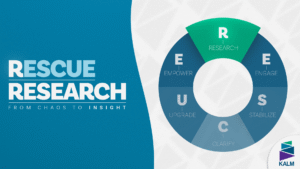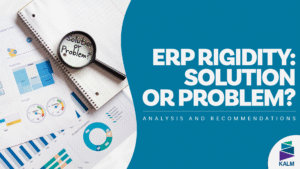This article is part of our ongoing series on ERP implementation failure, exploring “The Rigidity of ERP Systems” and how businesses can transform these challenges into strategic advantages.
ERP implementation failure often stems from systems that fail to adapt. In today’s fast-paced business landscape, agility and adaptability are critical to maintaining a competitive edge. Yet, many organizations find themselves constrained by Enterprise Resource Planning (ERP) systems that were meant to streamline operations but are now hindering innovation and growth. Could your ERP be holding your business back instead of propelling it forward?
Every second counts in a competitive market, and missed opportunities can create significant gaps. If your ERP system struggles to adapt to new market trends, shifting customer demands, or internal business changes, you’re not just sacrificing efficiency—you’re also compromising your ability to innovate and pivot when needed. The real challenge is not just implementing an ERP but ensuring that it evolves alongside your business.
Throughout this article, we will explore the warning signs of an overly rigid ERP, key methods to assess its flexibility, and practical strategies to optimize it—without undergoing a costly and disruptive system overhaul.
🧱 Signs Your ERP System Is Too Rigid
Before determining solutions, it’s crucial to identify whether your ERP is limiting your organization’s ability to innovate. Common indicators of ERP implementation failure due to rigidity include:
- Difficulty in Implementing New Processes: If modifying workflows requires extensive custom coding and long development cycles, your ERP may be restricting your ability to adapt to new business models.
- Lack of Integration with Other Tools: In the digital age, seamless system integration is essential. An ERP that doesn’t connect well with automation, AI, or analytics platforms limits real-time decision-making and efficiency.
- High Costs and Long Update Timelines: If each system update or enhancement demands excessive investment and extended downtime, your ERP is likely a bottleneck rather than an enabler.
- Overly Structured Internal Processes: If your ERP requires extensive reconfiguration every time your business changes, it reduces agility and responsiveness to market needs.
- Limited Scalability: If your ERP cannot scale with your company’s growth, operational bottlenecks will emerge, restricting expansion and user experience improvements.
🔍 How to Assess Your ERP’s Flexibility
A thorough evaluation of your ERP’s adaptability requires a multi-dimensional approach, blending technical assessment with user experience insights. Below are key evaluation methods:
1. Gap Analysis
Compare your ERP’s current functionalities with your evolving business needs. Engage key stakeholders from different departments to ensure no critical process is overlooked. For instance, if inventory management issues persist due to system limitations, it may signal that your ERP requires deeper configuration analysis.
2. System Integration Testing
Test how well your ERP communicates with other enterprise systems like CRM or HR platforms. A common issue arises when employee records in HR fail to update in the ERP, potentially leaving former employees with active system access—a serious security risk. Implementing API-driven integrations and middleware can resolve these issues and ensure seamless data flow.
3. Configurability Assessment
Many businesses underutilize their ERP’s built-in customization features. Evaluate whether employees rely on manual, repetitive tasks due to system limitations. Training staff to leverage advanced ERP features can improve automation and efficiency.
4. User Feedback Collection
Regularly conduct user experience surveys to uncover inefficiencies and pain points in daily ERP operations. Without structured feedback mechanisms, hidden inefficiencies can go unnoticed, affecting productivity.
5. Scalability and Performance Testing
Conduct load testing to assess whether your ERP can handle increasing users and transactions without performance degradation. If the system slows down or crashes under heavy loads, infrastructure upgrades or cloud migration may be necessary.
🔧 Strategies to Improve ERP Flexibility Without Replacing It
While system replacement is an option, optimizing an existing ERP can be more cost-effective. Here’s how:
- Middleware and API Integrations: Connect your ERP with modern applications to enable seamless data flow and process adaptability without modifying the core system.
- Add-On Modules and Specialized Solutions: Incorporate Business Intelligence (BI), Robotic Process Automation (RPA), and Process Management (BPM) tools to extend ERP functionality.
- Optimizing Internal Configuration: Regularly review and refine workflows, parameters, and system settings to ensure they align with current business needs.
- Agile Methodologies for IT Projects: Use short iteration cycles to identify and address system inefficiencies quickly, ensuring continuous ERP improvements.
- Expert Consultation: Engaging ERP specialists can uncover optimization opportunities and strategic system adjustments, maximizing your ERP’s effectiveness.
🧩 Future-Proofing Your ERP for Business Growth
If your ERP is causing operational bottlenecks and slowing innovation, it’s time to take action. Conducting a comprehensive assessment—including gap analysis, integration testing, scalability evaluations, and user feedback—can pinpoint specific weaknesses and guide optimization efforts.
By implementing strategic integrations, leveraging modular enhancements, refining internal configurations, and adopting agile methodologies, businesses can transform rigid ERP systems into agile, growth-enabling platforms. In today’s ever-changing market, ERP flexibility isn’t a luxury—it’s a necessity for maintaining competitiveness and seizing growth opportunities.
If your current ERP setup is holding your business back, don’t navigate the challenges alone. Contact us for a free consultation where we’ll assess your system’s flexibility and provide tailored strategies to turn your ERP into a true engine for innovation and success. Schedule your consultation today and unlock your ERP’s full potential!








